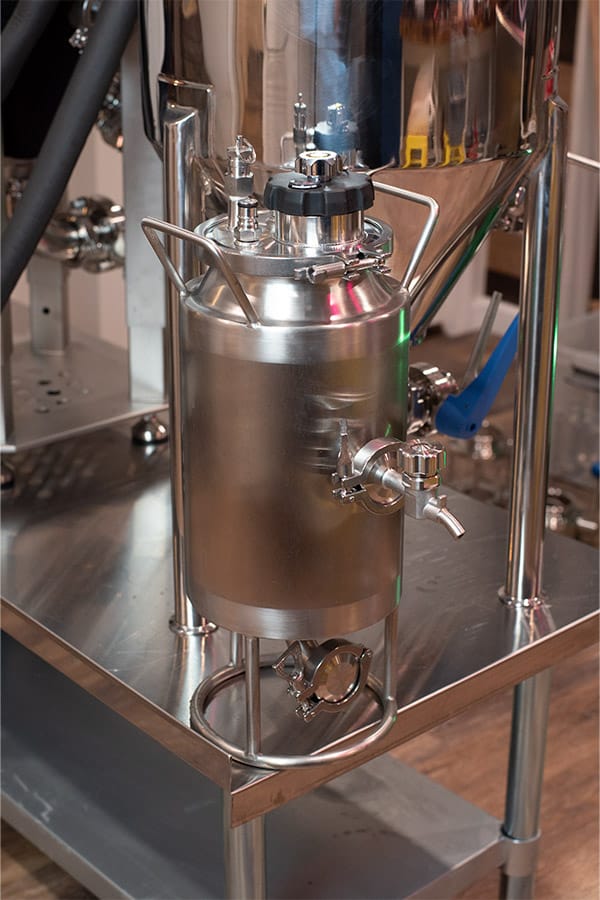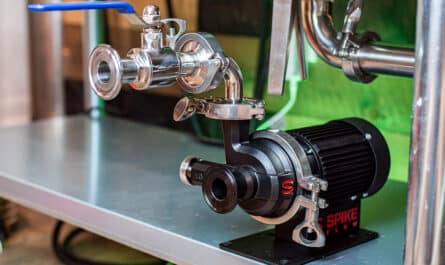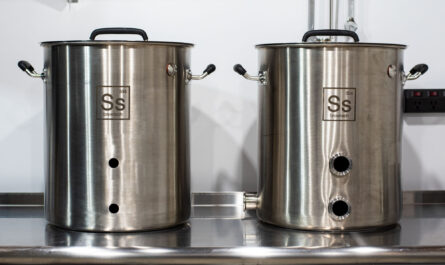Craft Master Growlers provided The Uni in exchange for an honest product review.
I recently got to ferment with arguably the world’s smallest functioning unitank fermenter. In 2022, Craft Master Growlers released a 1-gallon pressure-rated stainless steel unitank that features a true conical cone, dump valve, and sampling port. The init doubles as both a Pressurized Growler and fermenter, allowing you to both ferment and serve from a singular vessel with the ultimate degree of freshness. If you haven’t read my reviews on the CMG Keg Cap and Pressurized Growlers, you should give them a look
If you’ve read any of my yeast experiments in the past, you know I’m a huge fan of testing various yeast strains in 1-gallon batches. The problem with my experiments in the past was lackluster fermentation capabilities due to fermenting in mini glass carboys. While these work great for fermenting alone, they leave much to be desired in terms of professional capability and oxygen mitigation. Enter the “Uni”, a pint-sized fermenter with big features.
Product Overview
Craft Master’s Uni is constructed entirely from 304 stainless steel and comes in two finishes, mirror finish rose gold and matte stainless. The unit measures 18 inches tall by 12 inches wide. The top features a 6-inch TC plate with 2 interchangeable screw caps (standard and regulator). The regulator cap features a small pressure gauge, PRV tab, and disposable CO2 cartridge holder for portable dispensing. The standard cap is just a basic blank cap for transporting, fermenting, etc.




The 6″ stainless TC cap features gas and liquid keg posts and a built-in PRV, allowing you to connect to your existing kegging setup to pressurize and serve straight from your taps. The unit essentially functions as a much more sophisticated version of their pressurized growlers. The body of the Uni features two 1.5-inch TC ports. One for a dedicated sampling port and the other as a 1-inch dump valve.
The actual volume of these fermenters is 1.05 gallons with a design pressure of 43.5 PSI and a working pressure of 21.75 PSI.
My Experience
I put two of these mini fermenters to the test with a split batch of two different yeasts in the same wort. The trial beer was two hazy IPAs that were dry-hopped as much as possible given the batch size and fermenter scale. In terms of process, it could not have been more fluid. Obviously, this fermenter is very small so cleaning and sanitizing is very simple. Everything can soak right in the sink which makes the cleaning regimen very convenient. Read about my preferred brewery cleaner, Exchilerator Brewery Wash.




I attached 1.5 TC butterfly valves on the dump ports so I could actually dump the trub prior to serving. This is not included with the fermenter so it’s an additional accessory you will need to add. The overall process with these fermenters is more or less the same as fermenting in corny kegs. There are no external chilling or cooling coils so you will need to be more creative with temperature control. My basement is cool so the stainless steel kept everything fairly cool throughout fermentation.
I used a blowoff tube during active fermentation by attaching a spare tube to the gas post. This is the same practice I used to do in my keg fermenting days. Once my beers were finished fermenting I placed them in my fridge to crash, dump yeast/trub, carbonate, and condition. Because this tank is pressure capable up to 21 PSI, you don’t have to worry about oxygen suck-back during cold crashing.


Considering the size of these fermenters, along with the fact that they have a serving dip tube that extends deep into the cone (you can see this in the above picture), you can place them right in your keezer/kegerator and also serve your beer directly from the fermenter. This eliminates ANY oxygen exposure and obviously saved me some time. When it comes to brewing IPAs at such a small scale, oxygen exposure is even more of a concern.
Once my IPAs were finished crashing, I bumped the pressure up to 20 PSI to carbonate/condition over the next 2-3 days. Sampling these beers was a lot of fun and very successful. I did run into a bit of a hiccup with one of the dip tubes getting clogged with hop matter, however, it was relatively easy to clear. Both beers presented as very fresh thanks to zero transfers and zero oxygen exposure at any stage. This is about as pure as it gets in terms of a final product.
Downsides
The biggest benefit and challenge with this fermenter is scale. A one-gallon batch with trub, yeast, and hop matter is going to generate significant loss per the volume of the final beer. This is obviously to be expected with the types of beers that I brew and comes with the territory of very small batches.
Depending on the beer style, you’re generating 4-6 pints of finished beer per fermenter. While the small scale is clearly the designed application of this fermenter, I still think it’s worth noting. The real value of this fermenter is the freedom to run a series of experimental batches without the need to brew and potentially waste several 5-gallon batches of beer at a time.
The Craft Master Uni is priced starting at $425, making it one of the smallest, yet most expensive unitanks on the market. There is clearly a premium on such a specialized device with detailed components at a small scale. Space savings, small batch capability, dispensing, and ease of cleaning/transportation are what this fermenter is really designed for.
Final Thoughts

You may be asking who could benefit from such a small vessel? Small-batch stovetop brewers brewing 1-2-gallon batches can finally have some of the big fermenter capabilities as a fraction of the size. If you’re looking to enhance fermentation capabilities without committing to an oversized and expensive unitank, this could be your answer. Plus, since it doubles as a “keg” you can serve beer right from your kitchen fridge with minimal equipment other than a CO2 tank. If you factor in kegging equipment and kegerator costs into your budget, the Uni value really starts to shine.
Also, from what I’m told, these mini unitanks have taken off in the hospitality industry. Hotels and caterers are using The Uni to serve draft beer and specialty cocktails at events, conferences, you name it. Their sleek appearance and functionality are what really make them stand out.
If I had to forfeit ALL of my brewing equipment and scale way down on batch size, this would be a cool piece of multipurpose equipment that could at least keep me fermenting and kegging in a much simpler fashion.
Overall, I really enjoyed working with the mini Uni fermenter. It has a lot of surprisingly big features. The price point for the size is obviously a concern and poses a barrier for many homebrewers. Aside from pure fermenting capabilities, it looks really awesome so I keep it on display in my home bar when I’m not using it. Everyone who comes by is intrigued by my trophy of a fermenter.




